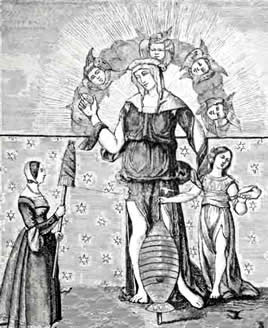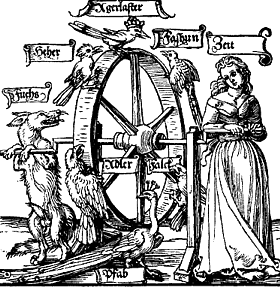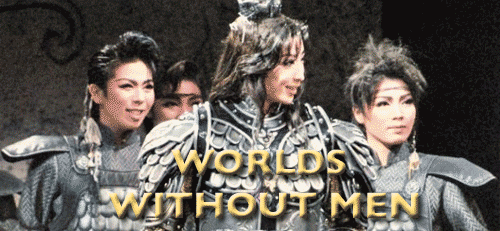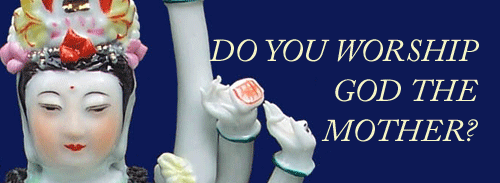The Wheel of Life
An Introduction to the Three Werdes

When we think of Werde, we are likely first of all to remember that she is the Janya of destiny – the divinity who governs our personal fate.
If we have any understanding of the inner workings of things, we do not suppose that anything happens to us by accident. We know that our "good luck" is the result of good actions performed by us in the past, whether in this life or in a previous birth; we know that our bad fortune is but the bitter fruit of past ill deeds. Everything is a part of this inexorable chain of cause and effect. The fact that you are reading these words at the moment is an opportunity earned by some previous good action; and whether you take the opportunity or ignore it will have a definite effect upon your destiny in this life and in those to come.
Werde, with a small w, is the thread that runs through all our lives – the motor which keeps them running. We all have countless werdes stored up for us – some good, some bad. Everything that happens to us is directed by them, from dropping a pencil to inheriting a fortune. If we ran out of them, the soul's life in the material worlds would come to an end. But that can never happen, for we have been accumulating them for life after life, and we are creating them all the time. Of course, we shall die in this life; but the time and manner of our death is simply another werde stored up for us, after which we we shall move on to the form of existence that we have earned while we were here.
But Werde is responsible for more than simply human fate; for it is she who governs the material manifestation of the entire universe. Thus, the more we understand of her profound symbolism, the more we shall understand of life and death and of the very nature of being itself.
Inseparable from the figure of Werde is the wheel that she bears and her sacred number, six. But the most striking fact about her is that while she is one Janya, she is also three persons – Maia the spinner, Werde the weaver, and Kala who cuts the thread.

Maia, the youthful maiden, is the creator of the manifest world. Werde, the mature maid, skilfully weaves all its events and personalities into the tapestry of manifestation. Kala, the aged maid, cuts the thread of being – this may refer to human death, to the collapse of a civilisation or to the eventual end of the universe itself. All these events are circular, for maids die and are reborn, civilisations rise, fall and rise again, and even the universe, after the night of time, shall be re-manifested. Hence the symbolism of the wheel that Werde carries.
The name Werde itself makes this clear. The closest English relation to this word is "weird" which originally means "fate". Shakespeare refers to this tradition – or to a folk memory of it – when he calls the three witches who foretell Macbeth's fate "the weird sisters". But it goes back to an Indo-European root √wer, to turn, closely related to √welw, to roll or turn. As regular readers will know, language contains a wealth of profound metaphysical truth and these roots are connected with some of the most fundamental words in the Indo-European languages including 'word' itself). A close study of this would reveal many of the deeper mysteries of the primordial philosophy, particularly as it relates to the process of manifestation. Here, however, we shall only consider those aspects which relate directly to Werde.
We must understand, to begin with, that turning or moving is the defining characteristic of the contingent world as opposed to the Absolute: "Earth moves, but Heaven is still". All movement is a turning (symbolised by the turning of the planet itself), because all movement takes place in time and time itself is circular. The idea of time as a straight line, assumed by the modern world, is simply the result of the short-sightedness of its philosophical perspective – a section of a large circle always appears to be a straight line, just as the earth seems flat to anyone standing on it. The apparently "unique events" of history are in truth but repetitions of certain archetypal patterns which must necessarily manifest themselves at their given point within the historical cycle.
The Wheel of Life continues after break
The root √welw brings out another aspect of this turning – we are perhaps most familiar with it in its Latin form: volve, where it gives us such words as involve, revolve and evolve. The last of these is the most interesting to us here, because it brings out the special secondary meaning of this root-group – the turning not so much of a circle as of a spiral. The historical cycle is pre-eminently a spiral, beginning at the central, principial point at the beginning of the Golden Age and moving ever outward into more and more "material" conditions, further and further from the spiritual Centre.

E-volution means literally "unrolling" and, in this sense, all things evolve. A tree "unrolls" from a seed; a culture "unrolls" from a single spiritual "idea" – or, in the case of a profane culture (a phenomenon belonging to the end of every historical cycle), from the inversion of a single spiritual "idea". Once we have fully grasped this, we shall see how modern Darwinism in particular and progressism in general is, like every great heresy, simply the perversion and misapplication of a great truth.
In the Filianist Ballad of the Bitter Withy, willow symbolises the binding of the Daughter to the wheel of Werde – this can be more fully understood when we realise that "willow" is a variant of √welw just as the Greek word helix means both "willow" and "spiral".
Having explained this, we may begin to understand some of the complexities of Werde. On the face of it, Maia, youthful, beautiful and all-bountiful, the giver of all the rich abundance of the earth, is the best of the three; Werde, giving with one hand and taking with the other, bearing a whip or willow-rod as well as a fruitful apple-bough, is ambiguous, while Kala, terrifying and hideous (whether aged or not), dancing on a corpse with a string of human skulls about her neck, often with a bloody sword in one hand and a severed head in the other, is positively evil.
However, traditional doctrine teaches us that the wicked stepmother in the fairy-tales is, in fact, a disguise of Maia. We are aware that while Werde is three persons she is only one Janya – that she may display at once the characteristics of all three or of any two, or may change suddenly from one to another: but this does not solve the problem in question, for when, in Mother Holle: or Cliona and the Three Caskets, the Maia-stepmother suddenly becomes Kala and "kills" her stepdaughter, then she is working in the best interests of the soul [see The Secret of the Three Caskets]. As a traditional saying about Werde has it: "When she is best she is worst, and when she is worst she is best."
This can be understood only when we realise that, from the highest point of view, the wheel of birth and death is a prison. One Scripture begins: "Bound upon Werde's iron wheel, the soul cries out for liberation".
The coming Golden Age will give place to a new Silver Age and eventually to a new Age of Iron even worse than the present one. "But where does it all end?" asks the modern mind, conditioned by linear history and the notion of progress. The answer is that it does not end. The wheel turns on for ever. The soul can only be free when she leaps off the turning wheel into the changeless perfection of the Spirit. This world of Werde is in fact a form of death for the soul. That is why the concept of fate and that of death are closely linked in language and traditional thought by the words "fate" and "fatal". "Doom" in older English also meant "fate".
We may see, then, how it is that Maia is sometimes called "the Great Witch" – the illusionist who keeps us trapped within the mirage of matter. One Scripture speaks of the two blind oxen which keep the wheel turning. One is desire for pleasure and the other is fear of pain. Is not that precisely what good and bad Werde instil in us; and is not the blindness of the oxen precisely the illusion of Maia?
So is it not really very simple? The truth about Werde is the precise opposite of the appearance?
Six, the number of Werde, is also the number of Sai Raya, the Sun. The willow, the tree of death, is also used for sprinkling the water of life, and its folk-name, sally, is closely connected with Saille, a name of the sun-goddess (in Irish, saille is the word for willow). These words are related to the Latin root sol, which gives us "solar" and (with the standard l-to-r transposition) to the ancient Indo-European Solar deity Surya/Syria. In Greek the "s" becomes "h", giving us helios "the Sun", whose close resemblance to helix, meaning both "spiral" and "willow" is far from accidental.
Here is a paradox indeed – for the Sun represents precisely the transcendent Spirit, the still point beyond all the turnings of the manifest world.
So which is Werde: is she the transcendent Sun or the turning world? The answer lies on many levels, but the simplest is that since this world of matter really is an illusion, it does not actually exist. It is simply a "disguise" of the Spirit Herself.
If we could cast off the illusion, we should already be in the presence of the Absolute. And likewise for ourselves. We have only to "become what we are": for in our true Self, we have never been separate from our Mother God; we have only suffered the delusion of separation.
This brings us to another name for the wheel of Werde. It is sometimes called the Wheel of Worth. "Worth" in this connexion means "becoming" cf German werdens another √wer word. If we are truly "becoming what we are", then we are literally worthy. That is also why something "becoming" is beautiful [cf The Philosophy of Beauty]. The whole of the turning world is but the "game" (lila) of our Mother God, "Who has laughed all the world into being".
We must take care not to misunderstand this latter doctrine, for the whole error of the modern world is based upon a confusion between the relative and the Absolute – a desire to deny the Absolute and to give an absolute status to the relative. Thus, for example, experimental science is abusively and illogically exalted to the level of a substitute for pure Truth: evolutionism seeks to explain creation purely in terms of the flux of matter: the modern world teaches that there are no absolute values, no absolute Truth, that material well-being is the highest goal of life. In short, all modern thought tries to make the turning world all in all, to put the change, relativity and transience of the material realm in the place of the Absolute.
The doctrine of the solar Werde is the reverse of this. It teaches that if we can see the illusion as illusion we begin to become aware of the spiritual Reality that underlies it.
Very much more might be said upon the subject of Werde, but from what has been said already, it is clear that there are many apparent contradictions and paradoxes in her nature, as one would expect in dealing with the flux and illusion of matter. The important thing to understand is that they are all true. The world is at once good and evil, both real and unreal. Werde is both deceiver and teacher.
The pure devotee of our Mother God can at once celebrate Maia the beautiful life-giver and fear the wicked stepmother. That is why she, unlike the modern materialistic person, can understand life.
See also:
Maia: the Angel, the Month and the World-Illusion
Please Support the Chapel of Our Mother God
Send Questions or Comments on The Wheel of Life
Chapel of Our Mother God Homepage
All written material at the Chapel of Our Mother God is copyright. Should you wish to reproduce any portion please contact us for permission.
Facebook or YouTube
![]()
This section:
Cycles of Time
Gospel of Our Mother God
The Gospel of Our Mother God is a collection of inspirational texts, prayers and daily inspiration for the Mother-Faith devotee or household.
The Feminine Universe
The Other Philosophy
Everything you have ever heard comes out of the patriarchal world-view. Its materialism, its religion, even its feminism. Here is the other way of seeing the world; the natural way: the way that everyone saw things before patriarchy and will again when patriarchy is long forgotten.



